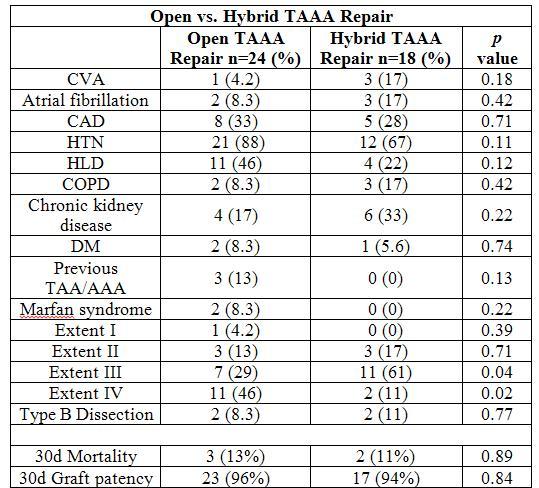|
Back to Annual Meeting Program
A Comparison of Open TAAA Repair vs Hybrid Repair: Single Institution Series
Dean J. Yamaguchi, Jr., MD, Mark A. Patterson, MD, Thomas C. Matthews, MD, Marc A. Passman, MD, William D. Jordan, Jr., MD.
University of Alabama at Birmingham, Birmingham, AL, USA.
OBJECTIVES: Hybrid thoracoabdominal aortic aneurysm (TAAA) repair has emerged as an alternative to open repair to reduce operative risk. Published reports consist of small series lacking in controlled data for comparison of hybrid TAAA repair to open TAAA repair.
METHODS: We retrospectively evaluated our experience comparing outcomes including morbidity and mortality in patients who underwent open or hybrid TAAA repair over a five-year period between 2006 and 2010.
RESULTS: Forty-two TAAA repairs, 24 open and 18 hybrid, were performed. Patients who underwent hybrid repair tended to be older (69.1 versus 61.8 years, p=0.07) and had more extensive aneurysmal disease (78% with extent II or III vs. 42% with extent II or III in the open group). Thirty-day mortality 13% and 11% (p=0.89) and visceral graft patency (96% open, 94% hybrid, p=0.84) was similar between the two groups. Post-operative incidence of spinal cord ischemia (8.3% open, 11% hybrid (p=0.77) and renal dysfunction (21% open, 22% hybrid, p=0.92) was also similar between the groups. One planned hybrid repair patient ruptured between visceral debranching and TEVAR and accounted for 1 death. Endoleaks were observed in 3 of the 18 hybrid patients (16.7%)
CONCLUSIONS: The hybrid TAAA technique yields similar 30-day mortality and complication profile to open TAAA repair in this series. While fenestrated stent-graft technology continues to develop, open visceral debranching followed by TEVAR may offer a reasonable therapeutic approach to a select group of patients with TAAA. 
Back to Annual Meeting Program

|

